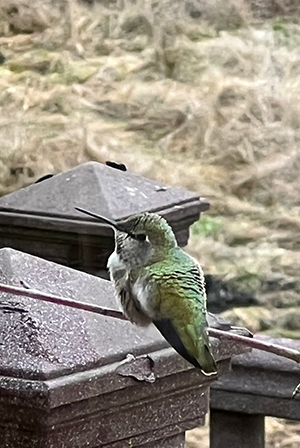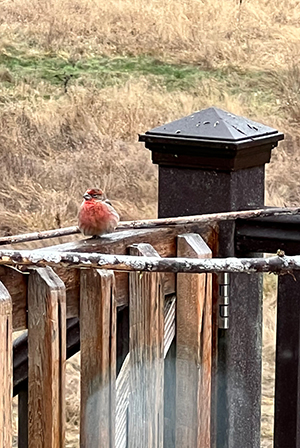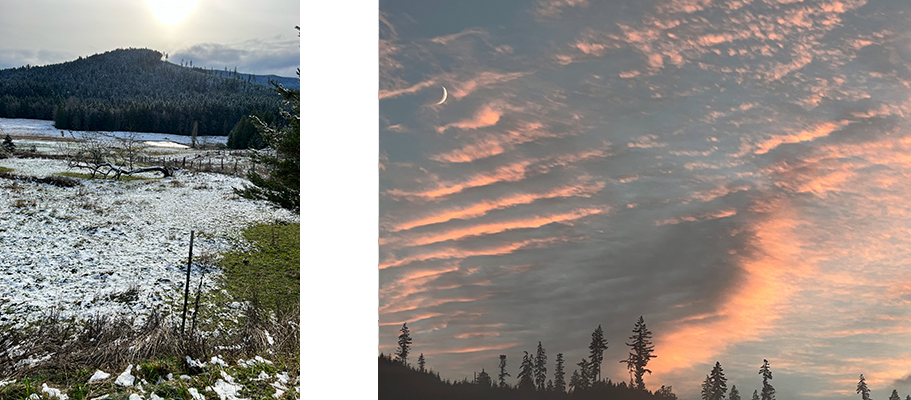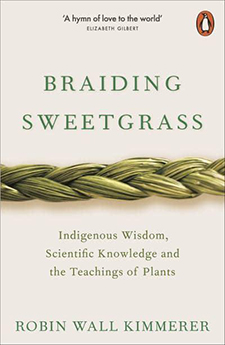 |
 |

Between the birds and the weather I can’t imagine how a person could ever be bored. (Okay, I can’t imagine that anyway, but I really can’t imagine it here.) First the “Christmas birds,” red breasted finch and green hummer and then a visitation in the snow by a cloud/cluster of red-winged black birds. The day was bright and sunny—I had to wear dark glasses in the kitchen while making breakfast—and then finished off with the sliver of moon amidst the pink clouds and soft gray of the fog. I rest my case.
Speaking of birds, I got some bird info from Sangha that I’m eager to put into practice. The first is about experiments being conducted in Northern California to see if increasing the owl population will inspire people not to use pesticides to get rid of mice and rats.
“The Department of Wildlife at Humboldt State University in Arcata, California, is working on a long-term study to assess the potential for owls to replace rodenticides as natural pest control for vineyards and winemakers. The research team has placed approximately 300 owl nest boxes throughout the Napa Valley and will document the impact of this on rodent control. Typical rat and mouse poisons are slow-acting and cause extremely painful deaths. They are also extremely toxic for other animals, including humans, and can build up in rodents’ bodies before dying—thereby exposing rodent-eating predators and scavengers like mountain lions and owls themselves to secondary poisoning. Many owls are apex predators, and much like other animals at the top of the food chain, supporting a healthy population means more sustainable biodiversity overall. The barn owl, in particular, has impeccable vision and hearing and is able to locate and catch mice moving underneath plant life or snow out in the wild. Adults’ wingspans can reach around four feet, but they typically weigh just one pound and fly in absolute silence.
I don’t know if it’s true, but I’ve heard that it’s too cold here for those particular rodents, not that we were going to be poisoning them anyway. I suppose the “too cold” applies if they’re kept out of heated spaces. Regardless, putting up habitat to appeal to the owls? Oh, yes.
The second piece of information is that finches are exceptionally fond of thistle. The thistle we have here is an invasive species, and it is definitely invading. I had thought we’d approach it as we approach the thistle at the Monastery, cutting it off close to the ground in the spring so it cannot spread. We’ll need to find out if there’s a native variety we can grow for the finches while removing the type that is not a good fit for this area. Or, perhaps we keep a patch for the finches and remove the rest. We shall have to see.
 |
Those of us enjoying Braiding Sweetgrass have, or will, depending on where we are in the book, encounter the guidelines of the “Honorable Harvest.” They so beautifully enumerate the ways we, practitioners of awareness, choose to be with Life that I’ve written them out so I can start off each day with keeping them in the front of conscious awareness. This can be a particularly difficult time to remember our reciprocal relationship with Life. We can easily get lulled into a focus on taking and forget the importance of our giving. Not just giving to those we know and care about, but to all Life.
|
 From last week: I made an error when I told you about the “Soul Roots Planner and Journal.” I neglected to let folks at keepitsimple.org know that I was going to suggest them as a perfect gift for one’s nature-loving self for the holidays. The journals are not on the website, but if you’d like one email support@keepitsimple.org and one will be sent. Here is what I wrote last week: “I came across a sustainably produced calendar that I find to be charming—I’ve long been calendar obsessed, most happy for a new year because it means new organizing tools—and asked keepitsimple.org to order some to be available for others who might enjoy it. Turns out it is created by folks who farm on neighboring Whidbey Island. They’re excited that we’re here and asked if we could be a part of next year’s planner. We got them for right at $20, and if you add $5 or so we’ll happily send you one. We have 20 copies. Those of you reading Braiding Sweetgrass will appreciate the tribute to maple trees on the inside front cover.”
From last week: I made an error when I told you about the “Soul Roots Planner and Journal.” I neglected to let folks at keepitsimple.org know that I was going to suggest them as a perfect gift for one’s nature-loving self for the holidays. The journals are not on the website, but if you’d like one email support@keepitsimple.org and one will be sent. Here is what I wrote last week: “I came across a sustainably produced calendar that I find to be charming—I’ve long been calendar obsessed, most happy for a new year because it means new organizing tools—and asked keepitsimple.org to order some to be available for others who might enjoy it. Turns out it is created by folks who farm on neighboring Whidbey Island. They’re excited that we’re here and asked if we could be a part of next year’s planner. We got them for right at $20, and if you add $5 or so we’ll happily send you one. We have 20 copies. Those of you reading Braiding Sweetgrass will appreciate the tribute to maple trees on the inside front cover.”
